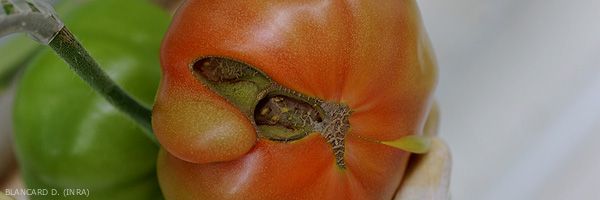
Corky stylar scar on fruit
( catface )
( catface )
The scar stylar corky is a fairly common physiological disease in tomato crops. It particularly affects the first fruits of early crops, in the open field and under cover, which are subjected to unfavorable conditions (too low temperatures) during flowering and fruit set. This results in the presence of more or less extensive and corky scars (figures 1 and 2), sometimes protuberances starting at the level of the stylar scar on the fruits.
Symptoms on fruits
More or less irregularly deformed fruits sometimes showing protuberances (figure 3), but above all corky scars more or less extensive and spectacular in their stylar zone (figures 2, 4 and 5). Thus, large irregular scars, strongly suberized and sometimes covering a large proportion of the fruits, are present at their extremity. There are also cavities sometimes revealing seed residues.
This disease mainly affects early crops in the open field and under cover which have encountered unfavorable climatic conditions during the flowering and fruit setting of the tomato.
It should be noted that several rots can start from the stylar and peduncular scars (see the heading Spots on fruit evolving into rotting .
Origin of damage
Non-parasitic disease
Flowering disturbances, and subsequently fruit set, linked to poor flower delivery and defective pollen quality.
Several factors influence the expression of this condition:
- the nature of the variety, cultivars with large multilocular fruits being the most sensitive;
- climatic conditions at the time of flowering, in particular during the 3 weeks preceding anthesis, too cold or too hot, as well as low light;
- the effects of certain herbicides (Figure 6), in particular 2-4 D;
- pruning, excessive nitrogen fertilization would also aggravate the catface .
How to cure it
Ensure maximum comfort to the plants during the flowering period of the first bouquets.
The climate
- Avoid keeping night temperature setpoints too low.
- Ensure optimal humidity in the shelters, especially not too low or too high.
Ferti-irrigation
- Do not add too much nitrogen fertilizer.
The plant and its behavior
- Cultivate less sensitive varieties: old and / or large-fruited cultivars with numerous carpellar cells appear to be more sensitive.
- Ensure a vegetative growth of the plants which does not penalize the exit of the bunches.
- Remove early deformed fruits in order to regulate the bouquets.





